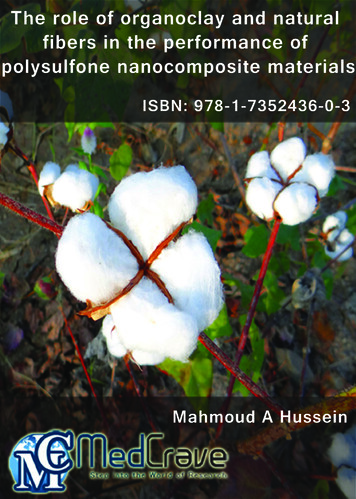
Transcription
3603MahmoudAHussein
The role of organoclay and natural fibers in theperformance of polysulfone nanocompositematerialsAbout the AuthorsRaed H Althomali,1 Abeer M Alosaimi,2 Omar A Thabet,1 Khalid A Alamry,1Abdullah M Asiri,1,3 Mahmoud A Hussein1,41Department of Chemistry, King Abdulaziz University, Saudi Arabia23Department of Chemistry, Taif University, Saudi ArabiaCenter of Excellence for Advanced Materials Research, King Abdulaziz University, Saudi Arabia4Department of Chemistry, Assiut University, EgyptCorrespondenceMahmoud A Hussein, Department of Chemistry, Faculty of Science, KingAbdulaziz University, Jeddah 21589, Saudi Arabia,EmailPublished By:MedCrave Group LLCMay 05, 2020
The role of organoclay and natural fibers in the performance of polysulfone nanocomposite materialsContents1. Polysulfone34.1.Polysulfone production3Properties of polysulfone34.2.5.Clay45.1. Classification of clay45.2. Structure and properties of clay45.3. Structure and properties of organoclay55.4. Polymer/clay nanocomposite morphology55.5. Clay and polymer modification for nanocomposite formation65.6. Polymer/clay nanocomposite production methods65.7. Morphological surface characterization techniques for polymer/clay nanocomposites65.8. Applications of polysulfone/clay nanocomposites66.Natural fiber86.1. Properties of natural fibers inside variable nanocomposites86.2. Modification of natural fibers116.3.11Application of PSF/natural fiber nanocomposites7.Polymer/clay/natural fiber hybrids nanocomposites118.Conflicts of interest129.References122
The role of organoclay and natural fibers in the performance of polysulfone nanocomposite materialsAbbreviationsNMP N-methyl pyrrolidoneDMSO, sulfolane dimethyl sulfoxideTMP trimethylolpropanePSFs polysulfonesEtO ethylene oxideESC environmental stress crackingWAXD wide angle x-ray diffractionTEM transmission electron microscopyCN clay nanoparticlesOMMT organically modified montmorrilloniteDMAC dimethylacetamidePVP polyvinyl pyrolidonePSFP olysulfoneCN clay nanoparticlesPEO polyethylene oxideMAPP maleated polypropylene1
The role of organoclay and natural fibers in the performance of polysulfone nanocomposite materialsAbstractAdvances made in the field of materials science leads to technological development. Nowadays, composite materials, usedin various fields such as engineering, industry, medicine are corrosion resistance and have lightweight and high fatiguestrength, and promise faster assembly –they can withstand loads, insulate or conduct heat and electricity, accept or rejectmagnetic flux, transmit or reflect light, be stable in hostile environments, and possesses all these characteristics costeffectively and with minimal impact to the environment. The chosen material needs to be compatible with the manufacturingprocess; because even with the right materials, an incorrect manufacturing process can be disastrous. This study displaysthe impact of organoclay and/or natural fibers on the performance of polysulfone (PSF) nanocomposite materials forvariable applications. First, PSF production and properties are outlined, and then a detailed study of organoclay and itsimportance as nanofiller in polymer matrices has been investigated, with a special attention to PSF. Properties of naturalfibers reinforced variable nanocomposites for wide range of application together with PSF in the form of nanocompositeshave also been researched and analyzed. Moreover, the recent research on the hybrid nanocomposite-based clay/naturalfiber in the presence of different polymers has been also displayed in details.Keywords: organoclay, natural fiber, polysulfone, nanocomposites, hybrid materials, electrical properties, neat polymer,neat polymer,clay platelets, PU chains, polysulfides, polyketones, nonsolvent, hydrophilic materials, fouling, polysulfones,plastics, cosmetics, phosphoniumcations, clay layers, polymer, biomedical applications, biomedical applications,microchemical, membrane’s permeability2
The role of organoclay and natural fibers in the performance of polysulfone nanocomposite materialsBackgroundPolymer–silicate nanocomposites are layered silicatesdispersed in a polymer matrix, which enhances the thermal,rheological, optical, mechanical, and electrical propertiesof the neat polymer. Many studies have explored otherpolymers following the research conducted by Toyotawhich demonstrated exceptional advancement in improvingthe properties of nylon-6 nanocomposites from clay, forexample, polyethylene, polypropylene, ly(ethyleneterephthalate), polycarbonate, polyurethane, polystyrene,polyamides, and epoxy resins, among others.1,2 Yanodeveloped polyimide/clay nano-composites from poly(amic acid) and montmorillonite and found that mixing lowconcentrations of montmorillonite silicate sheets decreasesthermal expansion, gas permeation properties and dielectricconstants of polyimide films.3–5 The bio–nano interactionbetween clay platelets and polyurethane chains in thesample, which was spray-coated, was also investigated insome studies. Clays were intercalated with and exfoliatedby polyurethane chains, which compatibly interacted withthe hard segments in polyurethanes. Thesestructuralarrangements of clay define and control the reactive sitesthat prove effective in interacting with PU chains. Thisimproved both physical and chemical interactions betweenthe scattered nanoclay and the polymer matrix in thecontinuous phase (a layer of polyurethane).6–8A number of studies demonstrated that the mposites are extracted from toluene diisocyanateand poly (propylene glycol) and toughened and hardenedeither by third-generation hyper branched (HB3) polyesterpolyol (HBP), trimethylolpropane (TMP), or glycerol(Gy). Compared to the controlled hyper branched PU,conventionally hardened by HBP and TMP, and theirnanocomposites, PU nanocomposites exhibited higherexfoliated morphology – a 23% improvement in storagemodulus at 25oC along with an onset degradationtemperature (5oC) improvement, which is the temperatureat which maximum degradation occurred (9oC), and 140%increase in tensile strength – when cured by HB3, whichcontained 8-wt% Cloisite30B.9 A one-pot synthesis of thecustomized poly(ethyl acrylate)/organo MMT-exfoliatednanocomposites was established by Datta et al.10 accordingto their findings, in the presence of organo MMT (Cloisite30Band Cloisite20A), the polymerization rate increased owingto the interface of the nanoclay and the carbonyl group ofthe monomer, which reduced the electron density of theC C bond, thereby leading to an increase in the monomerreactivity. Compared to a neat polymer, this polymerizednanocomposite demonstrated a 17oC shift in the glasstransition temperature, which was a significant finding.10PolysulfoneIn the last two decades, thermoplastic polymers with hightemperatures have been used in various applications; theyhave high heat resistance (200oC), strength, biocompatibility,extremely tight tolerances, and durability and are unaffectedby several cycles and doses of any kind of radiation. Theneed for materials with higher temperatures and higherperformances has resulted in the application of aromaticpolysulfones (PSFs), aromatic polyimides, aromaticpolyketones, and aromatic polysulfides in medical trays andelectronic components, surgical and dental instruments,drug delivery components, medical, and machined parts.Polysulfone (PSF) is a very significant membrane materialbecause it has competent mechanical, thermal and chemicalstabilities and is transparent and hydrolytically stable andis included in amorphous thermoplastics. Its hydrolyticstability is useful in applications that mandate repeatedcycles of steam sterilization. Moreover, it is stiff, rigid, andtough and have high chemical and heat resistance, whichenable the production of parts and products that demandhigh performance.11Polysulfone productionBisphenol salts that react with 4,4dichlorodiphenyl sulfone(4,4-DCDPS) can produce aromatic polysulfone, as shownin Figure 1.These types of reactions are usually conductedat temperatures ranging from 100 to 250oC in polar solventsthat have a high boiling point, such as sulfolane, dimethylsulfoxide (DMSO), and N-methyl pyrrolidone (NMP), withchlorobenzene as a co-solvent, which removes the waterthat is formed as an azeotropic mixture. The alkali salt is thenfiltered, and after the solution becomes cool, the previousmixture is poured into methanol, which is a nonsolvent. Thepolymer is precipitated, dried, and purified.11Properties of polysulfonePolysulfones are polymers that are transparent andamorphous. They have high heat resistance and strengthand glass transition temperatures 180oC – 250oC. Theseproperties make polysulphones receptive to repeated cyclesof steam sterilization and resistant to e-beam and gammaradiations. This is mainly due to its high aromatic content.Polysulfones can be used to inject molten material into amold or assembled in to precision parts. Table 1 describesthe important properties of PSF.11This includes the physicaland mechanical properties. In general, polysulfones havethe following properties:I. They are resistant to most aqueous acids and basesbut non-resistant to chlorinated organic solvents, suchas dichloromethane and chlorobenzene, and ketones,such as acetone and methyl ethyl ketone.II. They are thermally and hydrolytically stable and suitablefor both autoclave and steam sterilization; moreover,they can be sterilized with ethylene oxide (EtO) andgamma and e-beam radiation.III. They are used in implants, hemodialysis, and filtrationmembranes. Since they are hydrophobic, they areprone to membrane fouling. Hydrophilic materials suchas polyvinyl pyrolidone (PVP) can make their surfaceshydrophilic; polysulfones treated with PVP are usedcommercially in dialysis membranes.3
The role of organoclay and natural fibers in the performance of polysulfone nanocomposite materialsFurthermore, PSFs have an important property namedas welding property, through joining PSFs together. Sincewelding techniques with a high frequency are unsuitableto polysulfones, they can only be conjugated by vibrationwelding, heated tool welding, spin welding, infraredwelding, and ultrasonic welding. They can also be bondedwith solvents such as NMP, dimethylacetamide (DMAC),and N.N-dimethyl formamide (DMF) as well as acrylic andepoxy adhesives. Environmental stress cracking (ESC)should be avoided at all costs with the help of precautionarymeasures.11Figure 1 Synthesis of polysulfone.Table 1 Typical properties of polysulfoneFiberCellulose %Lignin %Diameter (μm)Hemicellulose %Elongation 711315.9-20.713-203ClayClay forms a valuable composition in porcelain, bricks, tiles,sanitary ware, paper, rubber, plastics, cosmetics, paints,and medicine. They are naturally abundant and economicalare not particularly harmful to the environment. It is a finelygrained natural rock or soil composed of clay minerals, suchas crystalline and hydrous aluminum phyllosilicates withvarying amounts of iron, magnesium, lithium, alkali metals,alkaline earths, and other cations. Clay is also made up oflayered silicates and small amounts of metal oxides andorganic matter.12Classification of clayClay is generally categorized into natural clay and syntheticclay. However, scholarly sources divide clay into three maintypes and many sub-types, as shown in Figure 2. Kaoliniteclay mineral is one example of 1:1 clay; they have only oneoctahedral group and one tetrahedral group in each layer.Clay minerals that have one octahedral sheet between twotetrahedral sheets are known as 2:1 clays, which includesmectite (divided into montmorillonite (MMT), nontronite,saponite and hectorite species), mica, vermiculite, andchlorite.9Structure and properties of claySilicate (SiO4) is a basic chemical unit of clay; it has onecentral ion, silicon, with a charge of ( 4) and each of thefour oxygen ions have a charge of (-2). Each silicon–oxygen bond has one-half of the total bond energy ofoxygen; hence, there is a tetrahedron-shaped anionicgroup with a charge of (-4). This leads the oxygen ion tobond with another silicon ion, thereby linking one SiO4tetrahedron to another and so forth.12 Mostly, phyllosilicates(2:1 layered) are used to prepare polymer nanocomposites.Since MMT is highly abundant and has a high surface area,it is typically used to fabricate polymer nanocompositeswith greatly improved properties.13,14 Its chemical formula,as shown in Figure 3, also makes it environment-friendly,organic, and inexpensive.12 The crystalline structure of4
The role of organoclay and natural fibers in the performance of polysulfone nanocomposite materialsMMT is composed of a layer of octahedral aluminumhydroxide sheet between two layers of tetrahedral siliconoxide sheets. Each platelet has a thickness of 1 nm anda lateral dimension of approximately 200 nm. These clayplatelets are heaped up on each other and bonded by Vander Waal forces, with 1 nm gaps (galleries). These galleriesare usually occupied by cations, such as Na , Li and K .These cations balance the negative charges generated fromisomorphic substitution within the layers(for montmorillonite,Al3 replaced by Mg2 ).15 Layered silicates can dispersewithin individual polymer layers, depending on interlayercations, and possess surface ability toward ion exchangereactions with organic and inorganic cations; these twocharacteristics are necessary for the production of polymerclay nanocomposites.16Figure 2 Classification of clay materials.Structure and properties of organoclayUnlike most polymers, which are hydrophobic, clays arenaturally hydrophilic. Hence, it is
Polymer/clay/natural fiber hybrids nanocomposites 11 8. Conflicts of interest 12 9. References 12. The role of organoclay and natural fibers in the performance of polysulfone nanocomposite materials 1 Abbreviations NMP N-methyl pyrrolidone DMSO, sulfolane dimethyl sulfoxide TMP trimethylolpropane PSFs polysulfones EtO ethylene oxide ESC environmental stress cracking WAXD wide angle x-ray .Author: Mahmoud A HusseinPublish Year: 2020











